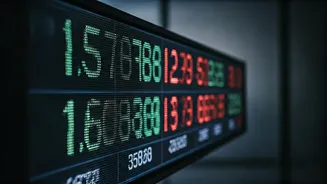Muhurat Trading Overview
Muhurat Trading, a unique trading session, is conducted annually on Diwali, symbolizing the beginning of a new Samvat year in the Hindu calendar. The session's
timing in 2025 was set for the day of Diwali. This brief but significant trading period is considered auspicious, with many investors believing that investments made during this time bring prosperity. The market's performance during this session often reflects the broader sentiment and expectations for the upcoming year. Investors, both seasoned and novice, look forward to this opportunity to initiate or adjust their portfolios, fueled by the festive spirit and the hope for positive returns. The Muhurat Trading session provides a condensed snapshot of market activity, influencing the overall financial landscape and setting the tone for future market behavior, with key indicators like the Gift Nifty and gold rates gaining attention.
Gift Nifty's Influence
The Gift Nifty, a key indicator reflecting the performance of the Nifty 50 index in the international markets, played a significant role overnight. Movements in the Gift Nifty often provide early signals regarding the potential direction of the Indian stock market during the Muhurat Trading session. Its performance is closely watched by traders and investors, as it can indicate the prevailing sentiment and expectations for the day's trading. Factors such as global economic trends, international news, and investor sentiment contribute to the Gift Nifty's fluctuation, which, in turn, influences the market’s opening and overall trajectory during the Muhurat Trading period. This makes it an important metric for anticipating market behavior and making informed trading decisions. Its impact is further amplified by other external factors influencing the market, creating a complex interplay of forces that define the trading session.
US-China Trade Dynamics
Trade tensions between the United States and China, particularly any easing or escalation in relations, had a direct bearing on market sentiment during the Muhurat Trading session. Positive developments, such as agreements or positive dialogues, often led to increased optimism and boosted market activity. Conversely, rising tensions, the imposition of tariffs, or negative policy announcements could negatively impact investor confidence and trigger volatility. The global economic landscape, heavily influenced by the relationship between these two economic giants, influences the trading decisions of investors worldwide. The impact of these trade dynamics extends beyond financial markets, influencing industries and global supply chains. Therefore, monitoring the evolving relationship between the U.S. and China is essential for understanding market trends and making informed investment decisions, particularly during a session like Muhurat Trading where sentiment plays a vital role.
Gold Rate Trends
Gold prices, a traditional safe-haven asset, are always in focus, especially during significant events such as the Muhurat Trading session. During the event, gold rates were a key aspect of discussion among investors. Increases or decreases in gold prices can reflect market sentiment, with rising prices often indicating a cautious approach among investors. The behavior of gold often provides an indication of investor perceptions of risk and economic uncertainty. Many investors consider gold a hedge against inflation and economic instability, leading to increased demand during uncertain times. The fluctuation in gold prices, therefore, offers valuable insights into the market's overall sentiment. Traders analyze gold price movements alongside other market indicators, like the Gift Nifty, to gain a more comprehensive understanding of the market during the Muhurat Trading session. Analyzing gold rates helps provide insights for informed trading strategies.
Market Overnight Shifts
Several other critical changes occurred overnight that influenced market dynamics during the Muhurat Trading session. These shifts could include changes in global market indices, updates from major companies, or shifts in investor sentiment influenced by recent economic data releases. These factors together influence the opening and course of the trading session, impacting investment choices. These overnight adjustments can affect individual stock prices and overall market indices, thereby defining market behavior. Traders and investors closely monitor these developments, assessing their impact on their strategies. This highlights the importance of staying informed and being prepared to adapt to dynamic market conditions. Understanding the impact of overnight shifts is critical for investors making decisions during the Muhurat Trading period, a time of significant trading and market activity.
Trading Strategy Tips
For the Muhurat Trading session, various trading strategies can be employed. This event is seen as a time for long-term investments. Strategies include diversification across different sectors, focusing on established companies with a history of stability, and considering stocks recommended by market analysts. Many investors often use this session to initiate or adjust their investment portfolios. The session's condensed nature means that short-term trading strategies might have increased volatility, so focusing on longer-term objectives can be prudent. Analyzing previous Muhurat Trading session trends can offer valuable insight. This period is a moment of opportunity for investors to reflect on their financial goals and use the auspicious time to plan investments, promoting a thoughtful and strategic approach to portfolio management, using the market's unique characteristics.














